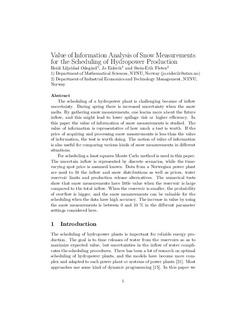Value of information analysis of snow measurements for the scheduling of hydropower production
Journal article, Peer reviewed
Accepted version
Permanent lenke
http://hdl.handle.net/11250/2475634Utgivelsesdato
2017Metadata
Vis full innførselSamlinger
Originalversjon
10.1007/s12667-017-0267-3Sammendrag
The scheduling of a hydropower plant is challenging because of inflow uncertainty. During spring there is increased uncertainty when the snow melts. By gathering snow measurements, one learns more about the future inflow, and this might lead to lower spillage risk or higher efficiency. In this paper the value of information of snow measurements is studied. The value of information is representative of how much a test is worth. If the price of acquiring and processing snow measurements is less than the value of information, the test is worth doing. The notion of value of information is also useful for comparing various kinds of snow measurements in different situations. For scheduling a least squares Monte Carlo method is used in this paper. The uncertain inflow is represented by discrete scenarios, while the time-varying spot price is assumed known. Data from a Norwegian power plant are used to fit the inflow and snow distributions as well as prices, water reservoir limits and production release alternatives. The numerical tests show that snow measurements have little value when the reservoir is large compared to the total inflow. When the reservoir is smaller, the probability of overflow is bigger, and the snow measurements can be valuable for the scheduling when the data have high accuracy. The increase in value by using the snow measurements is between 0 and 10% in the different parameter settings considered here.
